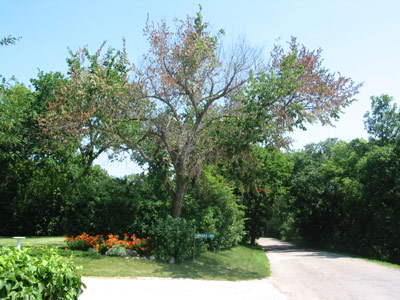Dutch Elm Disease Management Program
The RM of St. Clements participates in the provincial Dutch Elm Disease Management Program. In this partnership, provincial inspectors locate and tag diseased trees/wood, they provide the RM with a list of the trees and their locations and then the RM hires a contractor to remove them. The contractors begin removing trees typically in October, with them having until February to finish removal. You will be contacted by the contractor directly if they require access to your property. Learn more about the Dutch Elm Disease Management Program on the provincial website.
If you suspect that you have a tree or fire wood with Dutch Elm disease, call the Provincial Tree Line at 204-945-7866 or contact them via email at treeline@gov.mb.ca
Dutch Elm Disease FAQs
It is an aggressive fungal disease that blocks water movement in Elm trees and eventually leads to death of the entire tree. In Manitoba, the spores of Dutch Elm disease are usually spread by native Elm bark beetles. The native American Elm is most susceptible to Dutch Elm disease.
Basal spraying refers to spraying the bottom half metre of the trunk of all your elm trees with an insecticide containing “chlorpyrifos”. This prevents the overwintering of elm bark beetles, which may be carrying Dutch elm disease fungal spores. A 0.5% chlorpyrifos solution should be thoroughly sprayed into the cracks and crevices and around the root flares. Apply any time during August or early September and reapply every two years.
Prompt detection and removal of diseased elms is an important step of any Dutch elm disease management program. Promptly removing and disposing of elms dying from Dutch elm disease is the key to effectively managing Dutch elm disease on a community-wide basis. Removed elms need to either have their bark removed, be chipped, burned or buried.

